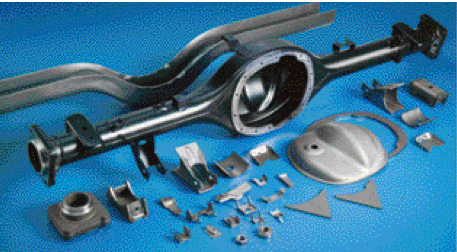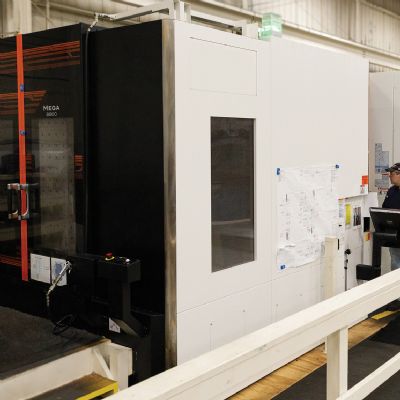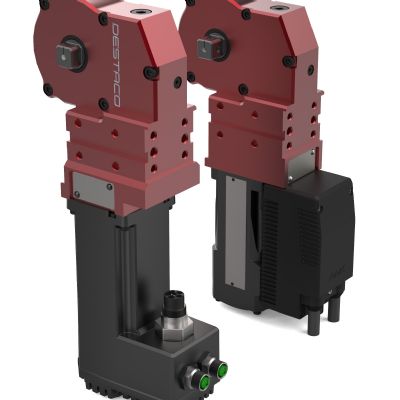“We immediately began work on the dies for producing the various stampings,” says Scott Duffie, 3-Dimentinal project engineer, “including the two axle halves—the upper and lower U-formed housing pieces that measure nearly 51⁄2 ft. long with a nearly 7-in. depth radius draw for the differential section. As die design and machining progressed, we turned our attention to the fixturing—the weld fixtures required to secure and accurately locate the 28 or so different pieces during the assembly process.”
“The design of these fixtures was very demanding for our welding experts,” he continues. “The workholding tools needed to be precise, yet highly adaptive, with adjustability to fine tune holding points and pressures, to compensate for or prevent distortion that could occur during the welding stages.”
The number of parts, quality checks and processes involved in completing the axles left open the possibility for multiple delays. In addition to the axle halves, other stamped pieces included baffles, front and rear backing plates, rear cover, front mounting ring, strengthening gussets, numerous brake cable guides and hose brackets, harness brackets, spring seats and reinforcements, shock brackets, drain plug inserts, and pipe brackets. The large upper and lower halves of the axle were formed in its 1600 ton press, one of 44 presses the firm employs. The stamping operation was sped along by the use of both Kirksite and aluminum alloys for die materials.
“We’ve tested various aluminum alloys and have found a particular one, we call it E-Z Cut, that holds up well for stamping prototype runs,” Duffie says. “The speeds at which the aluminum can be cut, however, helps to reduce machining times by 50 percent or more as compared to some tool steels.”
After the stampings were completed, some of the components, and in particular, the upper and lower housing halves, were laser trimmed using some of the company’s 13 five-axis laser cutters.
With the forming and laser trimming completed, the main section halves were welded together using the company’s robotic-welding stations, then each end of the housing was bored using one of the company’s large, bridge-style Awea three-axis machining centers featuring a 120 by 63-in. travel envelope and supplemental two-axis rotary fixture to accommodate the press fit of the wheel hub forging that was furnished by the automaker’s forging supplier. The next process: Assemble the hub forgings and weld them in place, then weld the miscellaneous brackets to the housing.
“A critical step in the welding, and a required process by the client, was to verify production intent by completing the wheel-flange welding process in a single, continuous weld,” notes Duffie. “To minimize tooling and equipment costs, we accomplished this by using two robotic arms in unison—one generating the weld while the second controlled the rotation of the part. With this weld, in fact with all the welds, we recorded all parameters of the individual welding processes, heat, cycle, etc., to provide the customer with data for production runs. At the same time, we had to conduct certified weld inspections in more than 50 locations on the assembly. We have on staff five certified inspectors along with a software program that helps identify and measure penetration depths, so these critical inspections could be completed quickly inhouse.”
Following the welding-certification inspection, each assembly underwent leak testing and CMM dimensional inspection.
With quality approval of these still-in-process axles, the assemblies were sent out for electrocoating, then brought back for final machining of the forged flange hubs, including hub diameters, bushing seal surfaces and ABS sensor mountings. After machining, the company performed a final CMM inspection.
“We were able to complete and ship the first pieces to the vehicle’s prototype assembly and test center within the 10-week time period,” Duffie says, “and are completing a second run of 17 to 20 pieces, incorporating some modifications and engineering changes. We expect to ship this lot in seven weeks. These prototypes included full verification of their manufacturing intent and process standards, so that, if this axle design is selected for future truck models, the automaker and its future high-volume suppliers will have a headstart to implementing a viable manufacturing process and a timely production launch. What’s more, the automaker has the production-like quality and integrity with which to gauge the functioning of these axles and to help determine their effect on overall vehicle performance.”
3-Dimensional Services: 248/852-1333; http://www.3dimensional.com
Industry-Related Terms: Alloys,
Carbon Steel,
Center,
Checks,
Die,
Draw,
Fixture,
Flange,
Form,
Forming,
Gauge,
LASER,
Penetration,
Prototype,
RunView Glossary of Metalforming Terms
See also: 3-Dimensional Services Group
Technologies: Tooling









